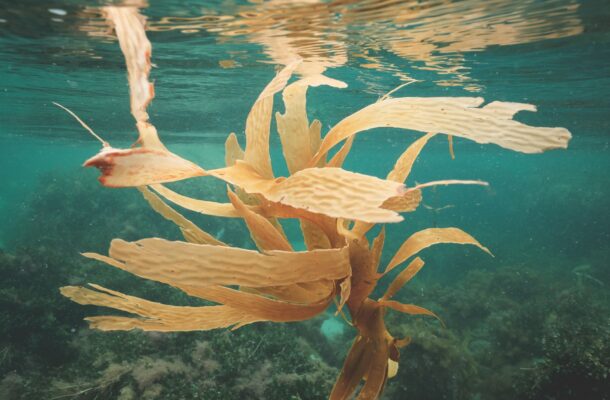Farming under the sea

Seaweed farming could free up millions of hectares of land and help cut carbon emissions if its true value is realised. Getting there takes time and investment.
In 2022, the New York Times declared industrial agriculture was “destroying ecosystems”, pointing to greenhouse gas emissions and issues with future supply and demand. The race to find viable alternatives is underway and one key part of the puzzle might be deep under water.
Seaweed farming — the practice of cultivating and harvesting crops in seabeds — is part of the expanding ocean-based blue economy. More seaweed farming may offer a way to relieve pressure on land by shifting the heightened need for crop production to the ocean.
Seaweeds could offer a wide range of co-benefits including supporting marine habitats, enabling diverse livelihoods in coastal areas and aiding in climate mitigation and adaptation.
Communities, researchers and commercial bodies have recognised this potential and are starting to explore large-scale seaweed farming.
But, despite their promise, the true value of seaweeds remains mostly undiscovered: just like land-based crops, seaweeds represent a highly diverse group and could be employed for many purposes in future industries, including as food, feed and fuel. Integrating seaweed into these systems could drastically reduce the environmental impacts of land-based agriculture.
At its most ambitious, seaweed could become prominent enough to form a fraction of diets, livestock feed and biofuel feedstock globally.
It would potentially free up millions of hectares of land currently used for land-based agriculture, unlocking space to increase carbon-storing forest coverage or reclaim abandoned areas.
Ramping up the use of seaweed could substantially mitigate the rise of future expected greenhouse gas emissions. For instance, supplementing ruminant livestock feed with seaweeds from the genus Asparagopsis could mitigate a significant amount of carbon dioxide equivalent emissions per year by 2050.
But these best case scenarios can only happen if technical, logistical and economic barriers are cleared. Producing the volumes of seaweed needed to achieve these scenarios, and delivering them to their respective end uses, will be a major challenge in the years ahead.
Before the sea can be blanketed by seaweed farms, comprehensive impact and risk assessments need to be carried out considering local contexts, uncertainty and the amount of risk that communities are willing to accept for developing their local marine spaces.
Managing the benefits and trade-offs of seaweed farming is a crucial starting step.
There’s a lack of clarity with respect to several impacts of seaweed farming, such as how the practice influences coastal and marine ecosystems, how well it is integrated into communities and its contribution to long-term carbon sequestration.
Addressing knowledge gaps is important, especially for ensuring seaweed farming near critical habitats for threatened and endangered species doesn’t pose any harm.
The existing seaweed industries in East Asia serve as examples of potential trade-offs. The success of seaweed farming in Tanimbar Kei, Indonesia led to overcrowding of farms in a restricted coastal area and a decline in environmental health and farm productivity due to competition for nutrients.
To avoid negative outcomes, a bottom-up approach driven by community needs may be required.
Learning from the failures of the palm oil industry may help manage unrealistic expectations about the benefits of seaweed farming.
Sustainable socio-ecological systems can only be achieved by accounting for, and addressing, local environmental and social costs incurred as seaweed farming expands alongside other blue economy industries.
Large-scale seaweed farming offers a promising pathway towards sustainable development and the growth of a blue economy, from supporting coastal communities to providing a novel source of biomass for food.
Realising this potential requires more research, advancements in technology and supportive policies.
But by recognising seaweeds as valuable resources and integrating them into global markets and sustainability strategies, we can realise the full power of our oceans.
This article was written by Scott Spillias, a PhD candidate at The University of Queensland working on large-scale seaweed farming; and Professor Eve McDonald-Madden, an ARC Research Future Fellow in the School of Earth and Environmental Management at the University of Queensland. Part of this research was developed in the Young Scientists Summer Program at the International Institute for Applied Systems Analysis, Laxenburg, Austria with financial support from the United States National Member Organization. Scott Spillias was funded by a Research Training Program Scholarship from the Australian Government. It was originally published under Creative Commons by 360info™.
Scott Spillias is a PhD candidate at The University of Queensland working on understanding how large-scale seaweed farming will impact a variety of sustainable development indicators, including the provisioning of ecosystem services, food security, land-use change, and carbon management.















